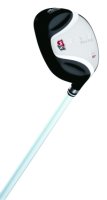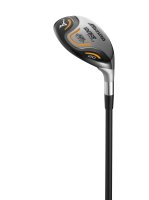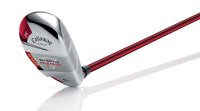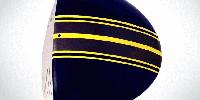Equipment Review - Fairway Woods 2009
By Scott Kramer
Fairway Woods Are Playing More Like Their Matching Drivers This Year
Ever since you purchased your first titanium driver, buying matching woods has seemed like a bad idea: Titanium fairway woods never truly gained momentum, because they were pricey and no one really ever wanted to hit a large-headed 5- or 7-wood directly off the turf. So club manufacturers migrated toward selling large titanium drivers along with vastly different sets of fairway woods and hybrids sharing the name but not the look of the driver. However, technology has allowed true families of drivers and woods to return like never before. Mind you, titanium is still not being used in fairway woods, which are instead made mostly of improved, stronger steel. And they resemble their matching drivers with lower, flatter crowns, geometric shaping, thinner clubhead walls and similar internal structures. Best of all, they perform comparably: Ball flight, trajectory, forgiveness, and to some extent sound and feel, all mimic the big stick. Play the entire set, and you'll find the distance gapping is consistently incremental, to boot. Odds are that if you like the driver, you'll quickly fall in love with the rest of the family.

Wilson Staff Spine
Their square-shaped clubheads look nice and clean - particularly to golfers who prefer smaller-looking woods to hit off the fairway and from light rough. Whether it's the shaping or the thick spine across the crown, these look more diminutive than competitor models at address, yet in reality are roughly the same size. The spine reinforces the center of the clubface, to increase ball speed and distance, while the perimeter weighting aims to keep the ball traveling high and straight. Ball flight is lofty and forgiving, in terms of both horizontal dispersion and distance, and is followed by a lively kick.
$249.99, wilsonstaff.com

Mizuno MX-700
Offered as an aesthetic complement to the matching driver, these woods feature a strong, thin lightweight steel clubface that's plasma-welded to a stainless steel body. That construction helps yield increased COR, maximum energy transfer to the ball, high trajectory, and fast ball speed. This combination's a winner. Shots launch pleasantly higher than similarly lofted competitors - from both tee and grass -- while feeling solid, and the ball quickly arrives at the target and lands lively. Best of all, ball flight is consistent. The clubface looks dead square, yet you can easily add some draw to the ball.
$199, mizunousa.com
Cobra S9-1
A new-and-improved version of the company's "9 Points" clubface technology - lower center of gravity (CG) and higher moment of inertia (MOI) -- yields this hotter, shallow clubface. The traditionally shaped, stainless steel clubhead extends slightly deep to the rear, increasing launch and forgiveness. It's a nice look that's subtly accented by shallow dimples, and sets up squarely behind the ball. The clubface grooves are etched into a pattern that frames the ball well at address. Impact feel is solid -- recognizably similar to that of the matching driver (as are the aesthetics) - and produces a crisp, non-metallic sound. Shots launch effortlessly and rocket out before hitting the ground running. Distance is impressive, which may be why Geoff Ogilvy has been tearing up the PGA Tour with the Pro version of the woods.
$225, cobragolf.com

Callaway Big Bertha Diablo fairway woods
These high-MOI, all-stainless steel Draw models are weighted and shaped specifically to help steer the ball left - although a Neutral version is also available. Variable clubface thickness boosts ball speed and raises forgiveness across the clubface. Impact feels powerful (beware: the 5-wood generates a notably higher-pitched sound than the 3-wood), producing a penetrating, high trajectory that carries well into wind. The ball lands softly with ample bounce and distance. While the sole plate's denoted by the number fairway wood it is, the smaller-headed Neutral version bears the club's degree of loft and less-pronounced ridges on top.
$199, callawaygolf.com
Nike SQ Dymo fairway woods
These square fairway woods look compact, which helps frame the ball well. They also have "Quad Keel Sole" angles -- four critical sole quadrants that help the club minimize interaction with the ground and encourage shots to travel straighter and longer. Weight is positioned in the corners, moving the CG back. As an added touch, the designers put light gray along the crown's perimeter to help soften the boxy-ness, and make the clubhead appear more traditionally shaped. Feel is solid, with a near-perfect impact sound. Ball flight is explosive, with plenty of left-and-right forgiveness. Hit it thin and the ball rises nicely while maintaining some clout. The standard UST wide-body shaft enhances feel, while the grips maximize traction on top and feel on the bottom.
$276, nikegolf.com
Article Tags: Equipment Review, Fairway Woods 2009
Revised: 04/15/2009 - Article Viewed 33,037 Times
About: Scott Kramer
![]() Scott Kramer, former senior editor of Golf Magazine, is a freelance golf equipment writer based in Carlsbad, Calif. - the unofficial capitol of the golf equipment industry. His work can be found on a regular basis in publications, such as T&L Golf, PGA Magazine, Met Golfer, Golf Tips and Private Clubs.
Scott Kramer, former senior editor of Golf Magazine, is a freelance golf equipment writer based in Carlsbad, Calif. - the unofficial capitol of the golf equipment industry. His work can be found on a regular basis in publications, such as T&L Golf, PGA Magazine, Met Golfer, Golf Tips and Private Clubs.












